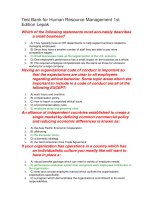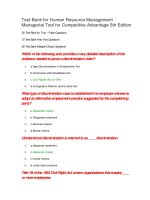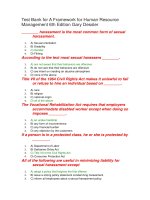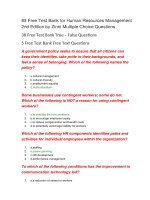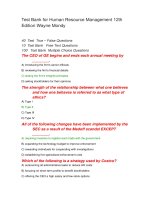Test bank for a framework for human resource management 6th edition by dessler
Bạn đang xem bản rút gọn của tài liệu. Xem và tải ngay bản đầy đủ của tài liệu tại đây (70.99 KB, 18 trang )
Full file at />A Framework for Human Resource Management, 6e (Dessler)
Chapter 1 Managing Human Resources Today
1) ________ maintain contact within the community and publicize openings.
A) Job Analysts
B) EEO representatives
C) Recruiters
D) Compensation managers
Answer: C
Diff: 2 Page Ref: 5
Objective: Chapter objective 1
2) ________ search for qualified job applicants.
A) EEO representatives
B) Job analysts
C) Recruiters
D) Training specialists
Answer: C
Diff: 2 Page Ref: 5
Objective: Chapter objective 1
3) ________ investigate EEO grievances.
A) EEO representatives
B) Training specialists
C) Recruiters
D) Job analysts
Answer: A
Diff: 1 Page Ref: 5
Objective: Chapter objective 1
4) ________ examines current organizational practices for affirmative action violations.
A) EEO representative
B) Training specialist
C) Job analyst
D) Compensation managers
Answer: A
Diff: 1 Page Ref: 5
Objective: Chapter objective 1
5) ________ collects detailed information about job duties.
A) EEO representative
B) Job analyst
C) Compensation manager
D) Recruiter
Answer: B
Diff: 1 Page Ref: 5
Objective: Chapter objective 1
buy this full document at
Full file at />6) ________ use detailed information to prepare job descriptions.
A) EEO representatives
B) Compensation managers
C) Job analysts
D) Recruiters
Answer: C
Diff: 2 Page Ref: 5
Objective: Chapter objective 1
7) ________ develop pay grades and compensation plans.
A) Compensation managers
B) Recruiters
C) Job analysts
D) Trainers
Answer: A
Diff: 1 Page Ref: 5
Skill: AACSB: Reflective Thinking
Objective: Chapter objective 1
8) ________ manage the employee benefits program.
A) Trainers
B) Benefits planners
C) Compensation managers
D) EEO representatives
Answer: C
Diff: 1 Page Ref: 5
Skill: AACSB: Analytical Skills
Objective: Chapter objective 1
9) ________ plan training activities.
A) Training specialists
B) Corporate teachers
C) Managers
D) Job analysts
Answer: A
Diff: 1 Page Ref: 5
Objective: Chapter objective 1
10) ________ organize all the training and development opportunities for a company.
A) Trainings specialists
B) Change managers
C) EEO representatives
D) Communication directors
Answer: A
Diff: 1 Page Ref: 5
Objective: Chapter objective 1
buy this full document at
Full file at />11) The ________ HR group focuses on using centralized call centers to provide specialized
support to the company's employees.
A) corporate
B) centers of expertise
C) transactional
D) embedded
Answer: C
Diff: 3 Page Ref: 5
Objective: Chapter objective 1
12) The ________ HR group focuses on assisting top management in strategic planning.
A) corporate
B) centers of expertise
C) embedded
D) transactional
Answer: A
Diff: 1 Page Ref: 5
Objective: Chapter objective 1
13) The ________ HR group focuses on being HR business partners to specific departments.
A) embedded
B) corporate
C) centers of expertise
D) transactional
Answer: A
Diff: 2 Page Ref: 5
Objective: Chapter objective 1
14) The ________ HR group operates like a specialized HR consulting firm.
A) transactional
B) corporate
C) embedded
D) centers of expertise
Answer: D
Diff: 1 Page Ref: 5
Objective: Chapter objective 1
15) The ________ HR group may provide specialized support for organizational change.
A) transactional
B) corporate
C) embedded
D) centers of expertise
Answer: D
Diff: 2 Page Ref: 5
Objective: Chapter objective 1
buy this full document at
Full file at />16) The ________ HR group may work with benefits specialists to provide support for
transactional HR activities.
A) corporate
B) embedded
C) transactional
D) compensation
Answer: C
Diff: 2 Page Ref: 5
Objective: Chapter objective 1
17) The ________ HR group operates as relationship managers for the corporation.
A) transactional
B) training
C) embedded
D) centers of expertise
Answer: C
Diff: 1 Page Ref: 5
Objective: Chapter objective 1
18) The ________ HR group works with the top management team to develop long range plans
for the company.
A) transactional
B) embedded
C) centers of expertise
D) corporate
Answer: D
Diff: 2 Page Ref: 5
Objective: Chapter objective 1
19) ________ is the process of acquiring, training, appraising, and compensating employees, and
attending to their labor relations, health and safety, and fairness concerns.
A) Human Resource Management
B) Labor Relations
C) Organizational Behavior
D) Organizational Health and Safety Management
Answer: A
Diff: 1 Page Ref: 2
Objective: Chapter objective 1
buy this full document at
Full file at />20) Human resource management is ________.
A) the concepts and techniques used to control people at work
B) the process of organizing work activities
C) the process of identifying countries with cheaper labor costs and relocating jobs to those
countries
D) the process of acquiring, training, appraising, and compensating employees, and attending to
their labor relations, health and safety, and fairness concerns
Answer: D
Diff: 1 Page Ref: 2
Objective: Chapter objective 1
21) ________ is the right to make decisions, to direct the work of others, and to give orders.
A) Leadership
B) Authority
C) Delegation
D) Management
Answer: B
Diff: 1 Page Ref: 3
Objective: Chapter objective 1
22) All of the following are a line supervisor's responsibilities for effective HRM except
A) coercing other supervisors to get with the program
B) controlling labor costs
C) developing the abilities of each person
D) orienting new employees
Answer: A
Diff: 3 Page Ref: 4
Skill: AACSB: Reflective Thinking
Objective: Chapter objective 1
23) Which of the following is a mistake you do not want to make while managing?
A) have your employees not performing at peak capacity
B) hire the wrong person for the job
C) find employees not doing their best
D) all of the above
Answer: A
Diff: 2 Page Ref: 3
Objective: Chapter objective 2
24) ________ are authorized to direct the work of subordinates.
A) Line managers
B) Staff managers
C) Advisory board members
D) All of the above
Answer: A
Diff: 1 Page Ref: 3
Objective: Chapter objective 1
buy this full document at
Full file at />25) ________ are responsible for assisting and advising line managers in areas like recruiting,
hiring, and compensation.
A) Human resource managers
B) Staff managers
C) Line managers
D) EEO officers
Answer: A
Diff: 1 Page Ref: 4
Objective: Chapter objective 1
26) Effective human resource management could include all of the following responsibilities
except
A) placing the right person in the right job
B) training employees
C) controlling labor costs
D) all are responsibilities necessary for effective human resource management
Answer: D
Diff: 2 Page Ref: 4
Objective: Chapter objective 1
27) All of the following are examples of human resource job duties except
A) recruiter
B) equal employment opportunity coordinator
C) financial advisor
D) labor relations specialist
Answer: C
Diff: 2 Page Ref: 5
Objective: Chapter objective 1
28) Which of the following job titles indicates a position in human resources?
A) recruiter
B) training specialist
C) EEO coordinator
D) all of the above
Answer: D
Diff: 2 Page Ref: 5
Objective: Chapter objective 1
29) ________ refers to the tendency of firms to extend their sales, ownership, and/or
manufacturing to new markets abroad.
A) Market development
B) Globalization
C) Export growth
D) Diversification
Answer: B
Diff: 1 Page Ref: 7
Objective: Chapter objective 3
buy this full document at
Full file at />80) Studies show that top managers still do NOT recognize teh crucial role human resource
managers can play in achieving strategic goals.
Answer: FALSE
Diff: 2 Page Ref: 17
Skill: AACSB: Ethical Reasoning
Objective: Chapter objective 5
81) A strategy is the company's plan on how it will match its internal strengths and weaknesses
with its external opportunities and threats.
Answer: TRUE
Diff: 2 Page Ref: 18
Objective: Chapter objective 5
82) Human resource management refers to the practices and policies organizations need to carry
out the personnel aspects required. What do these include? List 5.
Answer:
Conducting job analysis
Planning labor needs
Selecting job candidates
Orienting new employees
Appraising performance
Managing wages and salaries
Providing incentives
Communicating
Diff: 1 Page Ref: 2
Skill: AACSB: Analytical Skills
Objective: Chapter objective 1
83) Why are human resource concepts and techniques important to all managers? List 5 reasons.
Answer:
You don't want:
to have your employees not performing at peak capacity
to hire the wrong person for the job
to experience high turnover
to find employees not doing their best
to have your company taken to court because of your discriminatory actions
to commit any unfair labor practices
Diff: 2 Page Ref: 2
Objective: Chapter objective 1
buy this full document at
Full file at />84) Explain the difference between line authority and staff authority. What type of authority do
human resource managers have?
Answer: Authority is the right to make decisions, to direct the work of others, and to give orders.
Line managers are authorized to direct the work of subordinates and are directly in charge of
accomplishing the organization's basic goals. Staff managers are authorized to assist and advise
line managers in accomplishing these basic goals. Human resource managers are usually staff
managers because they are responsible for assisting and advising line managers in areas like
recruiting, hiring, and compensation. However, human resource managers do have line authority
within their own department.
Diff: 2 Page Ref: 3-5
Skill: AACSB: Analytical Skills
Objective: Chapter objective 1
85) What are the four main ways that technology improves HR functioning?
Answer: Technology improves HR functioning through self-service options, call centers,
productivity improvement, and outsourcing.
Diff: 2 Page Ref: 14-15
Skill: AACSB: Use of IT
Objective: Chapter objective 5
86) Describe the changing environment of Human Resource Management.
Answer: A suitable answer to this question would address the impact of globalization, off
shoring, technological advances, the changing nature of work, human capital growing
importance, demographic and workforce trends and the impact of "Generation Y." Examples
should be offered to support any opinions given and to bolster the argument that this does indeed
affect the environment.
Diff: 3 Page Ref: 14-18
Skill: AACSB: Reflective Thinking
Objective: Chapter objective 3
87) What are the four new ways to organize human resource services?
Answer:
The transactional HR group
The corporate HR group
The embedded HR group
Centers of Expertise
Diff: 2 Page Ref: 5
Skill: AACSB: Ethical Reasoning
Objective: Chapter objective 1
buy this full document at
Full file at />88) What are the five job duties for the human resource department?
Answer: Recruiters
Equal employment opportunity representatives
Job analysts
Compensation managers
Training specialists
Diff: 1 Page Ref: 5
Skill: AACSB: Analytical Skills
Objective: Chapter objective 1
89) List and explain 5 personnel mistakes you don't want to make as a manager.
Answer: The answer should include any of the following: to have your employee not performing
at peak, to hire the wrong person, to experience high turnover, to have employees not doing their
best, to have the company taken to court because of discriminatory actions, to have your
company cited for safety violations, to have undertrained employees and to commit unfair labor
practices. Because this is the first chapter material and the items listed above are not elaborated
upon the grader should allow for logical, even if incorrect, explanations for the chosen 5.
Diff: 1 Page Ref: 2
Skill: AACSB: Communication
Objective: Chapter objective 2
90) Why are demographic trends important to HR managers?
Answer: HR managers need to be cognizant of demographic trends because changes in the
availability of workers directly affect recruiting and selection efforts. The changes in the
workforce can impact the availability of technologically savvy employees or the availability of
skilled labor. additionally the availability of employees affect the compensation that needs to be
offered to attract and retain valued employees.
Diff: 3 Page Ref: 9
Skill: AACSB: Reflective Thinking
Objective: Chapter objective 3
91) Explain the concept of Strategic Human Resource Management.
Answer: A suitable answer would include the definition and an explanation of what it means.
Emphasis should be given to the involvement of HR in decisions before plans are made instead
of when plans need to be implemented. The student may also discuss the role of HR in spotting
trends that may become useful in the future.
Diff: 3 Page Ref: 20
Skill: AACSB: Reflective Thinking
Objective: Chapter objective 3
92) To what does human capital refer?
Answer: Human capital refers to the knowledge, education, training, skills, and expertise of a
firm's workers.
Diff: 1 Page Ref: 8
Objective: Chapter objective 2
buy this full document at
Full file at />93) To what does ethics refer?
Answer: Ethics refers to the standards someone uses to decide what his or her conduct should
be.
Diff: 1 Page Ref: 15
Skill: AACSB: Communication
Objective: Chapter objective 3
94) What is ethics?
Answer: Ethics refers to the standards someone uses to decide what his or her conduct should
be. Ethical decisions always involve morality.
Diff: 1 Page Ref: 13
Skill: AACSB: Communication
Objective: Chapter objective 5
95) Explain what it means to have authority.
Answer: Authority is the right to make decisions, to direct the work of others and to give orders.
Diff: 1 Page Ref: 3
Objective: Chapter objective 1
buy this full document at

